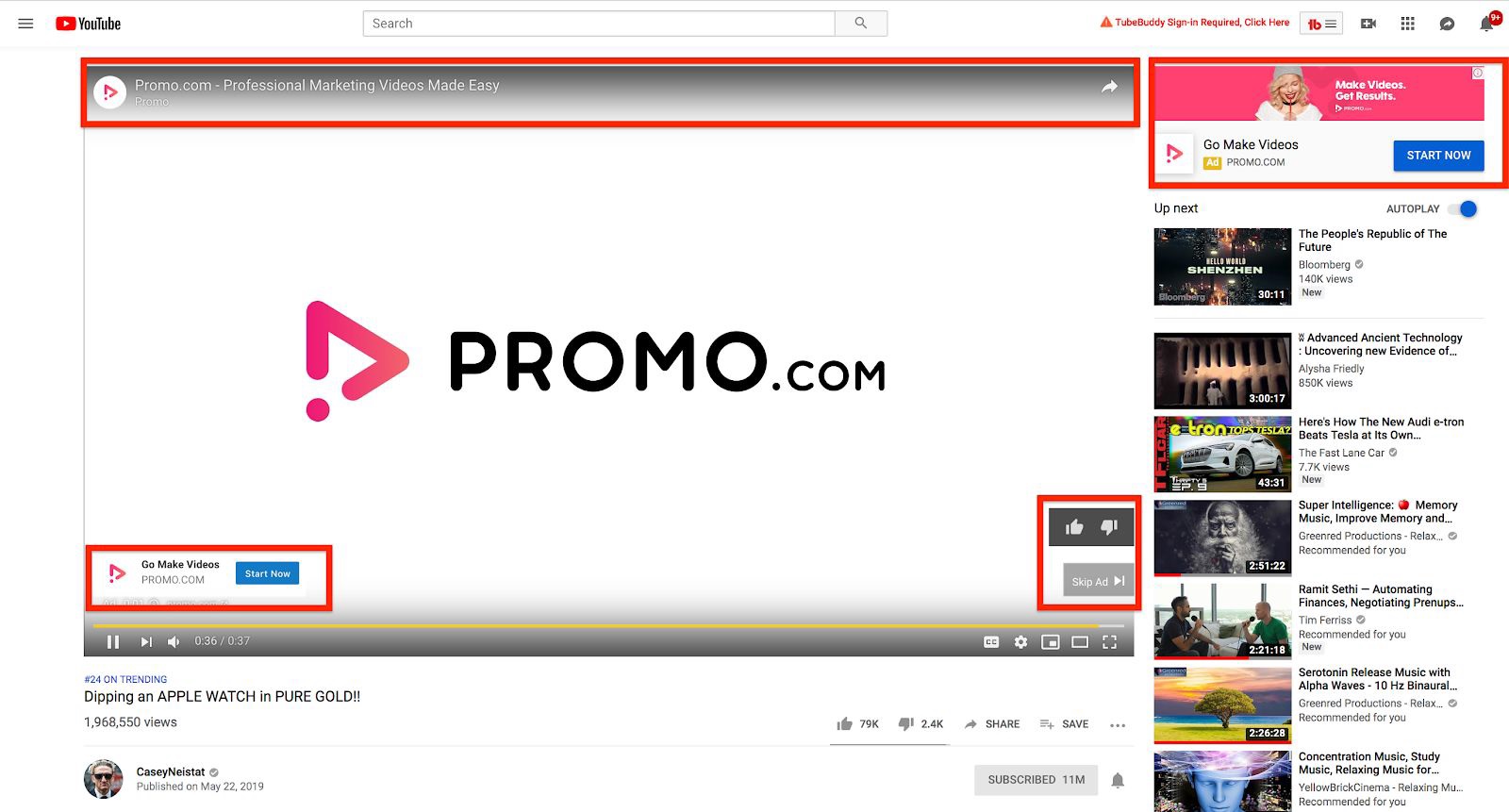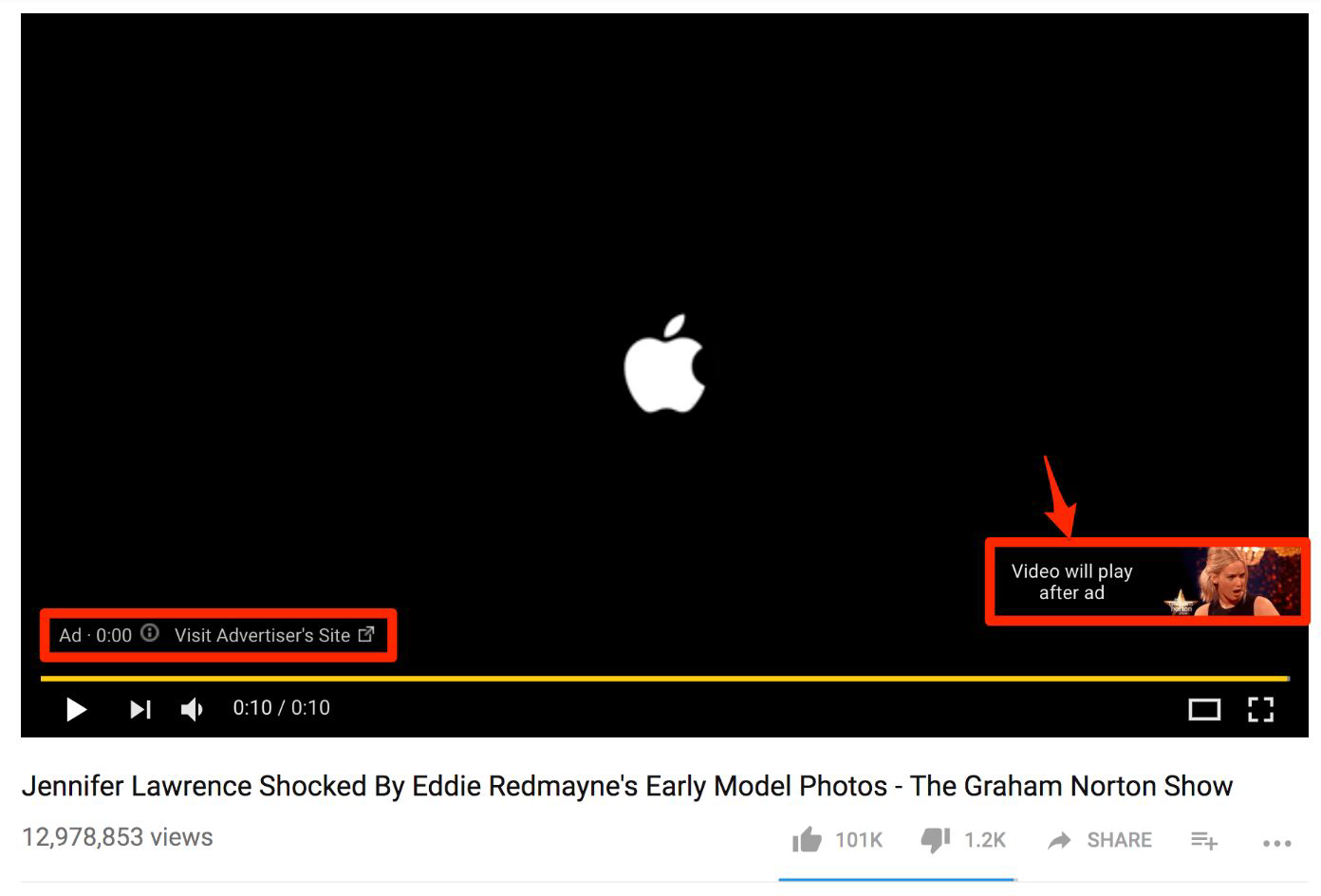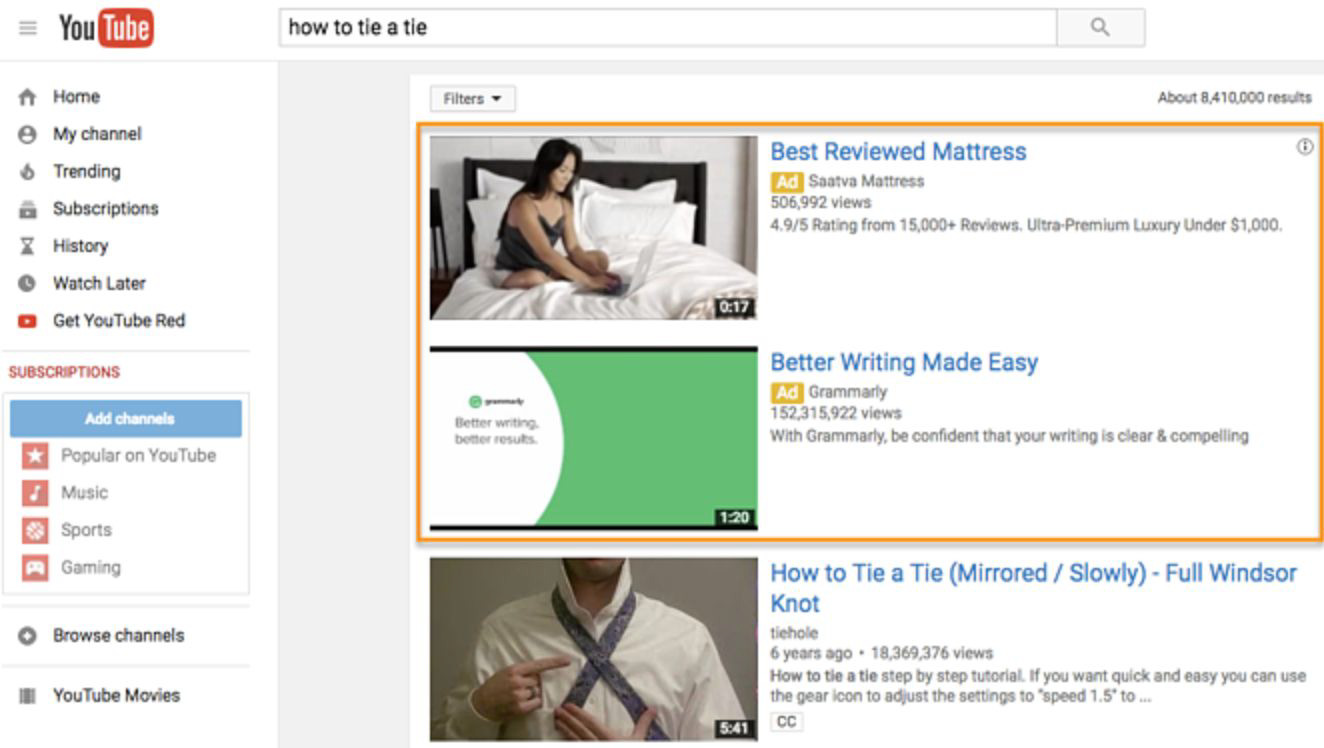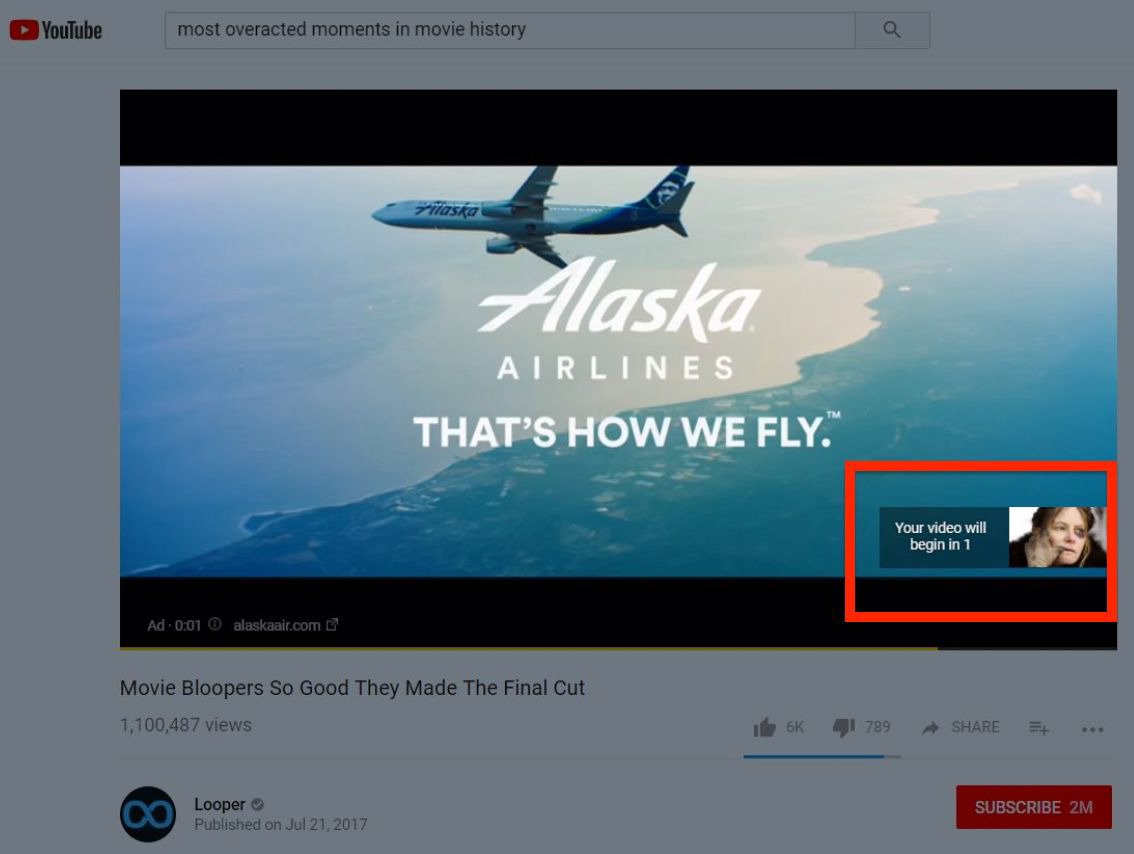YouTube, Adwords, Linkedin & Retargeting
You need to be where your audience is. So You need to get in front of them so they can discover you.
So, while it’s rare that you can’t reach your target audience through Facebook targeting, then test other platforms to establish the best Return on Ad Spend. as we mentioned in Youtube , Adwords , Linkedin. These are the best Advertising Platforms Alternative to Facebook
Most of the other ad platforms out there don’t have the same detail, depth, or usability as Facebook, but here is a broad overview of other ad platforms and the best strategies for using them.
1. Google Adwords
We advise you to only use Google Adwords if you have a proven product and a big advertising budget.
If you are a startup or medium-sized business that can’t afford to lose a lot of money trying to find out what works in order to get a profitable CPC then Adwords isn’t the right channel for you.
In general, it is very expensive and risky.
That said, if you (or your ad manager) are experienced with Adwords, have a good product, and want to try some new channels
,
Here are some tips for you to get the most out of your campaigns where people have a specific intent to purchase your product…
Automatic vs Manual Bidding
- Start with Automatic bidding so Google does the hard work for you and you save time.
- Manual bidding will allow you to reduce your CPA (cost per acquisition) and increase the visibility of your ads while allowing you to prioritize keywords and ads that convert better.
But Do not switch to manual bidding unless You have a Lot of Times to Monitor & Optimise, and Unless You know What you are doing!!..
Bidding Tips
- If keywords receive a lot of impressions but don’t have sales, reduce your bids
- Increase bids for high converting keywords regardless of their ad position
- If a set of keywords are converting, increase your bids
- Use the Adwords ‘average’ CPC (cost per click) from your automatic bids to determine your manual bids
- Monitor the performance of your campaigns and keywords per device (mobile or desktop)… if mobile performs better, increase bidding as appropriate
- Your bidding cost needs to be higher than your average CPC
- You won’t always pay the highest CPC bid you select
Remarketing & Segmenting
- Retarget to anyone who views your site but didn’t convert into a sale
- Set retargeting to 30-day window, to begin with, but test the duration options
- Segment retargeting based on your email lists or based on the pages visited
Build Campaigns in Search Networks Only
- Using the display network, and displaying your ads on Google’s partner sites drives unnecessary clicks and drives up costs
- Google’s Display network will put your ads in front of people outside of your target audience
- Search networks will be more expensive but will drive more targeted leads
- Only test Display network campaigns after search networks
- And for best results, use Display Network for retargeting to people who have already viewed your content
Run Campaigns at the Optimised Times and in the Right Places
- Adjust your keyword bids to run based on the best-performing devices, location, days, and times
- If an ad performs better on a certain day or time, increase the bid and vice versa
- Each product and industry will have different trends, so monitor and test which is right for you
Keywords Strategy
- Include long-tail keywords (phrases) to increase your views and clicks
- Consider the phrases, questions, and statements your customers will use in search
- This is essential for smaller businesses with lower budgets
- These keywords will have lower click-through rates but will be more targeted
- Long-tail keywords pre-qualify buyers and capture customers with buying intent
Do not compete with High Competitive Keywords if you have a Low Budget or just Starting out or If a Big Brand is going after the same Keyword
Adwords Copy
- Ad copy is the first introduction to your site that people will see of you and your brand
- As previously stated, the keyword strategy will lean heavily on query-based searches
- So, the ad copy needs to highlight that we have the answers to the question/s that the user has asked
Landing Page Strategy
- The key to success will be the quality of the landing pages that the traffic is pushed to
- If your keywords strategy is focused on keywords where the search terms are not normally associated with a high level of buying intent, each landing page will need to work hard to convert that user
Competitor Ad Swipe
- Use your data and research content from the competitor research section to discover your competitors best ad copy and keywords
Final thoughts
Google Adwords is a highly advanced strategy. You can make it a lucrative and scalable channel, but the ROI for many businesses (especially startups) doesn’t work, and it’s a highly risky tactic.
This is why we haven’t dived into detail on the traffic methods. So use it with caution.
For those of you with established brands and big budgets, work with a high-quality PPC specialist or agency to cover the above and much more to ensure your campaigns are fully optimized.
2. YouTube
Youtube advertising has been rising in popularity for the last few years. Major brands use it, and smaller startups use it because Video sells! And, the biggest attraction to Youtube is the fact that you can run campaigns and only pay for video views over 30 seconds!
That means that you are only paying for viewers who have shown a very strong interest in you and your offer, and are more likely to go down your sales funnel.
So, depending on your budget, it is worth putting some aside to try out a Youtube campaign to see how it performs against Facebook Ads.
Here’s an overview of when and how you should bring Youtube advertising into your growth strategy.
Types of Youtube Ads
There are a number of ways to promote your brand on Youtube with video ads available in various ad formats.
You can have skippable in-stream ads, non-skippable in-stream ads, video discovery ads, Outstream ads, and bumper ads.
The terminology can get a little confusing if you are new to it, as Youtube has changed the naming setup over the years. But here are the main different ad types you can run (all of which you manage from within your Google Adwords account)
1. TrueView Ads (Skippable)
2. Non-skippable In-stream Ads
3. Discovery Ads
4. Bumper Ads
1. TrueView Ads (Skippable In-Stream Ads)
TrueView ads are the skippable ads that appear at the beginning of YouTube videos. Playing ads or apps in the Google display network is also an option.
.
Viewers only have to watch the first 5 seconds of the ads before they can skip them. TrueView ads are known to get three times as much ROI as Non-Skippable ads.
2. Non-skippable In-stream Ads
Yep, these can be annoying, but they are part of Youtube. The maximum length for these ads is now 20 seconds and there are two types:
- Pre-roll ads: which appear before a video plays
- Mid-roll ads: which appear at the midpoint of 10 minute-or-longer videos
Forcing the viewer to watch the ad drives engagement up but it naturally drives ad-abandonment up too.
3. Discovery Ads
You’ll see these videos in the suggested videos section of YouTube’s main page or as suggested/related videos when you do a search.
4. Bumper Ads
Unlike non-skippable advertising, bumper ads are only six seconds long at the most. They appear at the end of YouTube videos and are paid for on a CPM basis (cost per thousand impressions)
Why You Should Use Instream Ads
While you can certainly try out other types of ads on Youtube, we suggest initially starting with Instream Ads. Here’s why:
- You only pay-per-view of your ad.
- And a “view” is defined as when someone either watches your full ad or 30 seconds of your ad, whichever happens first!
- This means that you will not be charged if a user clicks away from your ad after five seconds.
- The cost per view is just a few cents and people are engaged!
- There are a LOT of targeting possibilities across multiple countries (see below)
- Retargeting options are expanded as YouTube works with the AdWords network. This allows for additional targeting while allowing you retarget to people who visit your website pages.
Setting Your Campaign Up
- You will need a YouTube account and a Google Adwords account.
- Connect your YouTube to your Google Adwords account.
- Your landing pages for your ads need to be both YouTube and Adwords compliant
- Ensure your Adwords pixel is on your website
A YouTube Strategy
There are a number of similarities in YouTube and Facebook. This will give you an entire traffic system for your sales funnel. As a reminder you should:
- Set up an ad for cold leads
- Send cold leads to lead magnet page to capture email
- Ensure pixel is installed on lead magnet page
- With your tripwire ad, target visitors who opened your lead magnet.
- Ensure pixel is installed on TripWire page
- People who purchased your tripwire are likely to be interested in your main offer ad, so remarket to them.
- Ensure the pixel is installed on the core offer page
- Retarget people who bought your core offer for your profit maximizer ad
Capturing Attention with Instream Ads
If people can skip your ad after 5 seconds of seeing it, you have to capture their attention quickly. To begin with, you need to choose the EXACT ad objective. It could be to:
- Get signups for your lead magnet
- Drive people to sign up for a webinar or event
- Get people to make a small purchase
- Increase subscriptions to your YouTube channel
- If you are targeting cold traffic you should give value without asking for a big ask. As we’ve previously explained in the funnels, get them to a lead magnet.
Writing the Ads
You can use the same Ad Copy and Sales Page frameworks to write your ads in YouTube… Remember the pain points of your customers, their challenges, their reservations, and where they want to be.
Then show them how you can get them to their dream state.
1) Intro with the hook statement and headline
2) Excite them about their dreams
2) Reason and remove their fears of taking action
3) Rationalize their failures
4) Confirm their suspicions
5) Throw rocks at their enemies
6) The Bind (or hook reaffirmation)
Video Types
Depending on your business and brand you can use a variety of ad types. This can be a selfie video or a highly produced commercial.
It depends on your budget and brand of course, but if you’re a startup or SME, we suggest making it as personal and raw as possible so you can reduce cost and increase the learning time.
- Use your smartphone
- Film in the office, at home, in a cool location or small studio
- Use an employee, yourself, or any personal brand or personality
- Use local videographers to help shoot and edit if needed
Animated / Explainer Videos
Don’t want to get in front of the camera or feel like your product would be best suited to a different style? Use the platforms below to create, or find somebody who can create an animated video:
Demonstrator Videos / Screenshare Videos
If you want to just show (rather than tell) what’s under the hood of your product… you can record it using a number of programs, including:
- Screenflow (for Mac)
- Camtasia (for PC)
Upload Your Ad to Youtube
Once you have your ads created, you need to make sure your youtube channel is set up to give you credibility. Here are some basic tips:
- Sign up for your YouTube account with a professional sounding username in line with your brand
- Upload your logo or a professional photo
- Add a cover photo
- Write up a brief and clear description in your about sections
- Link to your other online presences, including your blog and social media accounts.
- Include links to your other online followings, such as your Facebook page and website.
- Include a brief description of the video and relevant keywords and tags in the video description.
Target the Right Keywords
To make sure your ads get in front of the right people, use keywords for your ad targeting, just like Google Adwords.
We recommend using this method in addition to the ‘placements’ method shown below. Despite building your ads within Google Adwords, Youtube Ads are cheaper than Adwords because the competition on the platform is smaller.
So you’ll pay less for impressions and clicks than you would on AdWords search, should you have a good performing ad.
- Research keywords by conducting some searches on YouTube to see what videos appear
- Don’t use single keywords or broad phrases
- Be as specific as possible when describing your objectives. The answer is yes, even if it implies a smaller audience.
If viewers don’t find your ad to be relevant, YouTube will show your ad less often and start to increase your ad bids.
Use the Placement Targeting Option
You should also use the placement targeting options in addition to keywords. Especially if you’re just getting started with YouTube advertising. You’ll be able to decide exactly where your advertisements appear.
To ensure that your adverts appear in the right videos, you can choose which videos or video channels to target.
Rather than allowing Google to try and figure it out, you can tell Google where you want to appear. If you want to promote your fitness products in front of BodyBuilding.com content… then you can.
This can take more time to research and can be difficult to scale, but it’s a great way to test your ads in the beginning.
It’s also a great way to steal the attention away from your competitor’s channels and content
Target By Interests & Topics
It’s a good idea to target your audience based on their interests and subjects. Targeting people based on their previous viewing habits is possible thanks to a feature called “Interests.”
Topics – refers to the stuff that a viewer is now looking for.
As an example… if somebody might like to watch business marketing videos which signal their interests… but at that moment they might be searching for ‘gym workouts’ which is a topic. So, in that moment, it’s probably better to target
somebody with a fitness workout as they are in that topic mode… rather than a business product as they aren’t currently focused on that topic.
This is a good option to test out for your targeting, but it isn’t as targeted as using the keywords or placement options.
Retargeting
If you haven’t got the message yet that you should be retargeting within all of your paid media, then you should go back and read the strategy.
Retargeting can and should happen in your YouTube campaign. So make sure your Adwords Pixel is installed on your website.
Once someone has visited a part of your website that has the remarketing pixel, you can retarget them with specific YouTube ads and take them down your funnel.
3. LinkedIn Ads
Linkedin is the largest network of professionals in the world who tend to have a budget for higher-priced products. So if you are a SaaS company or are selling info products to B2B (business to business) then Linkedin will be a good platform to test.
It does generally have a high cost per click average but if you are selling a high-priced product you should consider the potential ROI to see if you can make it work.
For example, if you’re selling a $50-$100 product, it might be a little too expensive to scale and profit from. But, if you have a product that you sell at the enterprise level for $1000+ then this could be perfect for you.
Keep in mind that 80% of Linkedin users want to connect and engage with other businesses on the platform to improve their decision-making. And… 50% of users say they are more likely to buy from a business on LinkedIn rather than other options.
So… you will need to be active in providing them with content and interacting with them in order to be successful on the platform.
Linkedin’s ad platform has improved a lot over recent years to the point where you can use very similar setup processes.
Linkedin Action Points
- Targeting will allow you to focus on business types, locations, job roles/titles, seniority, skills, etc and you can use lookalike audiences based on your lists and retargeting options
- Use the same video scripts formulas, and headlines, etc that you use for other ads, just be sure to adapt your tone to a more ‘professional’ environment
- Advertise your lead magnets as your main objective to capture the email addresses of prospective customers. If you are advertising on Linkedin, your product should be priced at a point that usually requires relationship nurturing via email.
- Optimize your company page for credibility
- Give value and build trust to start a relationship with your customer
- Test different ad formats: Inmail, Text Ads, Sponsored Posts/Content
- Join Linkedin groups and engage
- Create your own Linkedin in group
- Publish articles, videos, infographics directly on Linkedin
- Follow Up and Retarget customers on other platforms (email, Facebook, etc)
Check more articles:
How to Analyze Competitors Ad Campaigns
How to Decide Lead Magnet Topic and 5 Lead Magnet Examples
What is Recurring Commission and Advantages
How To Use YouTube Ads For Amazon FBA
7 Best Alternatives to Google Adsense
Retargeting
We have talked about Retargeting with each paid ad campaign above. Retargeting is the glue that holds everything together and takes the user on a journey that builds a relationship with your brand. It can lift conversion rates by +20% or even higher.
So you’ll need to utilize retargeting to capture leads that getaway and sales that didn’t close.
You should make set up retargeting campaigns wherever you are running paid ads. So that could be on Adword, LinkedIn and Youtube. And, if you are running a Google Display Campaign, then that too should be used for retargeting.
To take it a level further, you can also use Retargeting platforms such as Adroll & Criteo, which can expand the delivery of your ad in the same way as Google’s Display Network.
Your ads will show up as banner ads on the Adrolls network of sites. This will give your ads even more exposure, getting in front of the same audience to stay top of mind.
You can use a site like creatopy to make quick and affordable banner artwork optimized for the various display sizes.
Consider Following a Course ?
With Lifetime Access ?
We have been the number 1# platform for delivering most demanding course. Becoming Lifetime Member , You will receive all the Premium content For FREE

Consider Following a Course ? With Lifetime Access ?
We have been the number 1# platform for delivering most demanding course. Becoming Lifetime Member , You will receive all the Premium content For FREE








